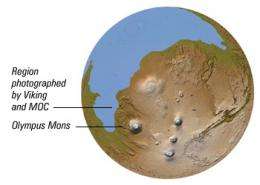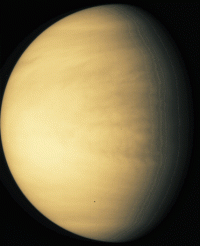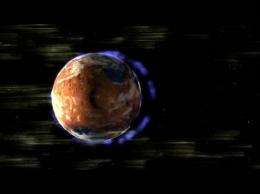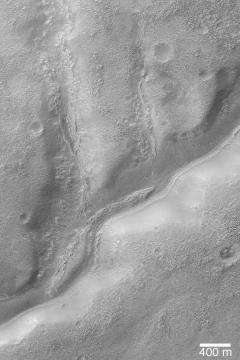Mars was Wet, but was it Warm?

Mars is frozen today, but when it was young there may have been liquid water on its surface. What does the latest evidence indicate about the ancient martian climate? Understanding the past environment of Mars can help future missions "follow the water" in the search for alien life.
On Mars today, water is frozen solid. The average temperature of the Red Planet is negative 55 degrees Celsius (-67 F), and when the temperature rises -- the highest recorded temperature is a balmy 20 degrees C (68 F) -- this ice turns directly into a gas, skipping the liquid phase entirely because of the low atmospheric pressure.
Mars may have had a thicker atmosphere and liquid water on its surface between 3.5 and 4 billion years ago. Satellites orbiting Mars have taken images of ancient ocean shorelines, river beds and canyons - features all thought to be caused by flowing water. The chemistry of the martian soil also suggests that liquid water may have been present once on the surface. If so, then perhaps life could have emerged on Mars during this time in its history.
Many scientists think Mars was cold when it was young - cold enough so that surface water should have been frozen solid. One way around this problem is if the chemistry of the water was such that it could remain liquid at lower temperatures. On Earth, the salt in seawater prevents it from freezing at the same temperature as freshwater. For early Mars to be cold but still wet, however, the water would have had to be much saltier than seems likely.
Another possibility is that Mars was warmer in the past. At first glance this idea doesn’t make sense -- the Sun was fainter back then, so the planet should have been even colder in the past and then gradually warmed up as the Sun grew brighter. But sunlight is not the only way to warm a planet; an atmosphere also can help keep conditions toasty. Just look at Venus -- its thick greenhouse atmosphere has raised its average surface temperature to a searing 464 degrees Celsius (867 F).
Could Mars also once have had a greenhouse atmosphere that warmed the planet enough to keep water flowing across its surface?
Jim Kasting of Penn State and Brian Toon of the University of Colorado discussed the possibility of a warm and wet Mars at the recent NASA Astrobiology Science Conference in League City, Texas.

Kasting explained that the climate models haven’t found a solution for warming early Mars, because the greenhouse effect is “self-limiting.” Adding different types of gases to the atmospheric models can help increase the temperature, but these same gases create clouds which reflect sunlight back into space, cooling the planet. The two effects compete with each other up to a point, but then eventually you end up with a colder planet because the added gases develop so much cloud cover. Climate modelers have looked at greenhouse gases like methane, carbon dioxide, sulfur dioxide, and water vapor, but so far have not hit upon a good way to warm ancient Mars.
"We've spent 30 years on the greenhouse effect and no one has solved the problem in a credible way so far,” noted Toon. “On the greenhouse problem, we're just drifting into deeper and deeper complexity."
Why does the greenhouse climate work so well to heat up Venus but not Mars? The thick clouds of Venus also bounce a lot of sunlight off into space, and that reflection is why we’re not able to see the surface of Venus in the visible light spectrum. One answer is that Venus is much closer to the Sun, so it receives substantially more sunlight than Mars does. According to Toon, another reason is that Mars is little. The lower gravity of a less massive world reduces the rate that air cools with altitude. On Earth this rate is about 10 degrees Kelvin per kilometer, but on Mars the rate is about half that. “This makes it harder to get a greenhouse effect, giving you less ‘bang for the buck’ for your greenhouse gases,” Toon said. “Mars is hard to warm up because it’s so small.”
Toon believes that, rather than a greenhouse atmosphere keeping Mars warm and wet, the canyons and river beds we see on Mars formed due to periodic asteroid and comet impacts. In this scenario, impacts would have filled the atmosphere with vaporized rock and ice and resulted in several years of rainfall and flooding that created the erosion features on Mars.
“We know the impacts occurred - we can see the craters there,” said Toon. “It's pretty much impossible to avoid there being large amounts of water coming from them.”
Kasting, however, doesn’t agree that impact events created the features seen on Mars. He pointed to Nanedi Valles on Mars, which he said was "essentially a Grand Canyon, on a slightly smaller scale." Kasting estimates it took roughly 5 million meters of water to form the Grand Canyon on Earth over 17 million years. The same amount of rainfall would have been needed to form a feature like Nanedi Valles on Mars, ten to one hundred thousand times more water than an impact could generate.
Kasting also noted that features in Warrego Valles looked similar to oxbow lakes on Earth, which are made slowly over time by meandering rivers. If the formations on Mars were made by a similar process, then the water must have been flowing persistently, rather than quickly and catastrophically as would have been the case from impact-related flooding.

Toon countered this by pointing to features on Earth that formed quickly, such as the Salton Sea flood in California where a river was carved in approximately nine months to a similar depth and length as some of the channels on Mars. “You can certainly carve significant terrain in nine months,” he said.
Scientists disagree on how long it might take such features to form on Mars because of the lack of absolute age data. To get that information, we would need to analyze rock samples from the features in the laboratory. “All our age dates come from crater counts, and that is not an accurate science by any means, especially when you’re trying to resolve issues of how long it took to form valleys,” said Kasting. “The only thing we know how long it takes to form are impact craters, because they’re created instantaneously.”
The quality of the soil may provide some clues to the time it took features to form on Mars. If the soil is looser, in the manner of loamy sand rather than bedrock, it would erode much more quickly. Kasting said the surface of Mars is mainly basalt - a hard crust that would be comparatively resistant to erosion. “The surface of Mars may be somewhat more erodible than rocks on Earth, but not by a factor of ten to the fourth," he said.
Toon disagreed. "If you have all these large impacts, you're going to create about a kilometer of regolith,” he said. “This is loosely consolidated material that's covering the planet about a kilometer deep, and that's very likely where these rivers formed due to impacts."
The chemical make-up of the soil is another avenue for trying to understand early Mars. On Earth, carbon dioxide in the atmosphere reacts with water and silicate rocks and is converted into calcium carbonate (limestone). The martian atmosphere today is primarily composed of carbon dioxide, and scientists have long wondered why we could never find evidence for carbonates in the soil. NASA’s Phoenix mission finally found carbonates on Mars, but in very low amounts.

Earth’s carbonates tend to form in shallow warm waters like the sea near the Bahamas, rather than in colder areas like the North Sea. The low abundance of carbonates on Mars may indicate the planet has always been cold.
However, the carbonates found by Phoenix are not thought to have formed in standing water. Instead, scientists think they formed through the chemical interaction of carbon dioxide and water vapor as minute particles of basalt blew on the wind.
The paucity of carbonates may tell us something about the composition of the early atmosphere. If, for instance, sulfur dioxide was ever part of the martian atmosphere, carbonates would have had a hard time forming.
“Sulfate in rain would prevent carbonates on surface, but you don’t even need that,” said Kasting. “If you had a 3 bar carbon dioxide atmosphere on Mars, rainwater would be pH 3.7 and would dissolve any carbonates.”
In the end, Kasting and Toon were in perfect agreement on one point: the environment of ancient Mars remains a mystery. Every new bit of information is another piece of the puzzle, and eventually we’ll fit enough of these pieces together to construct a clear picture of the Red Planet’s earliest days.
Source: Astrobio.net, by Leslie Mullen


















